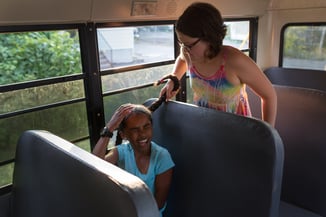Most school bus rides go smoothly and remain incident-free. But sometimes students need a little gentle discipline to encourage better bus behavior. What can you do to ensure that all students exhibit proper school bus conduct?
Safety comes from the top down
Many parents are understandably nervous about sending their  children on the school bus for the first time. The school district’s transportation department can allay some of those worries by communicating clearly in advance of, and throughout, the school year. Make sure parents receive a copy of the department’s written behavior policy. Urge parents to review the rules with their children and also make sure students understand the consequences of misbehaving on the bus.
children on the school bus for the first time. The school district’s transportation department can allay some of those worries by communicating clearly in advance of, and throughout, the school year. Make sure parents receive a copy of the department’s written behavior policy. Urge parents to review the rules with their children and also make sure students understand the consequences of misbehaving on the bus.
 children on the school bus for the first time. The school district’s transportation department can allay some of those worries by communicating clearly in advance of, and throughout, the school year. Make sure parents receive a copy of the department’s written behavior policy. Urge parents to review the rules with their children and also make sure students understand the consequences of misbehaving on the bus.
children on the school bus for the first time. The school district’s transportation department can allay some of those worries by communicating clearly in advance of, and throughout, the school year. Make sure parents receive a copy of the department’s written behavior policy. Urge parents to review the rules with their children and also make sure students understand the consequences of misbehaving on the bus.Encourage parents to get to know their child’s driver and maintain a friendly, courteous relationship. This way, drivers and parents will feel comfortable discussing the child’s school bus conduct with one another. Often, a simple conversation and positive reinforcement is all that is needed to correct any misbehavior.
Parents and students need to understand that the school bus driver has the same authority as a teacher or principal, and students must respect the driver’s right to enforce the rules.
 Behavioral expectations and school bus safety should be discussed with students at the beginning of the school year and rules should be visibly posted on the school bus.
Behavioral expectations and school bus safety should be discussed with students at the beginning of the school year and rules should be visibly posted on the school bus.
 Behavioral expectations and school bus safety should be discussed with students at the beginning of the school year and rules should be visibly posted on the school bus.
Behavioral expectations and school bus safety should be discussed with students at the beginning of the school year and rules should be visibly posted on the school bus.Bullying on the school bus has received a lot of media attention in recent years. Fortunately, initiatives to prevent bullying are making a big difference, and students are becoming increasingly aware of how to combat bullying. Share the department’s anti-bullying policy with school administrators, parents, and students to ensure no one becomes a bullying victim or instigator. It is important to keep careful records and report any incidents immediately.
Different ages, different methods
School bus conduct issues vary based on the age of the students. Let’s take a look at each age group:
-
Kindergarten to 4th grade: Remaining seated is the biggest school bus conduct problem with children of this age. This group must be taught to take their seats, put on their seat belts, and respect others. A good solution is bus buddies: older children who pair up with younger ones to show them appropriate behavior.
Proper use of the seat belt is another problem because buses have a variety of restraints. Many have lap belts, which tend to be too loose and difficult for small hands to tighten. Students must learn to make seat belts tight enough, and drivers must remember to check students’ seat belts. Some buses have retractable seat belts, which tighten more easily.

K-4 students are at the age where they might fool around and tease each other. Drivers should remind them that this is not proper bus conduct and show them fun school bus games they can play instead.
-
Middle School: These students have a lot of energy and may enjoy pushing the envelope. Kids this age sometimes need extra monitoring to maintain proper school bus discipline. Some districts provide bus aides who ride along with the driver to supervise students. In addition, school buses can have security cameras on board to monitor and record student behavior.
One discipline issue among middle school students is eating on the school bus. Choking poses a danger to children eating on the bus. Also, some children have life-threatening food allergies, so it’s vital that no eating takes place on the bus.
-
High School: Students in grades 9-12 go to school very early in the morning and are often half asleep or listening to music during their ride. By the time afternoon rolls around, they are eager to begin their extracurricular activities, homework, or jobs. However, students this age sometimes curse, fight, spit on the floor, or play loud music. Students or drivers who witness any inappropriate behavior should report it to the school.
Students of all ages sometimes throw objects out the window, including everything from backpacks to shoes. Drivers need to make it crystal clear: nothing goes out the window of a school bus. Most students have cell phones these days. Remind them that taking pictures or video on the bus can interfere with the driver.




